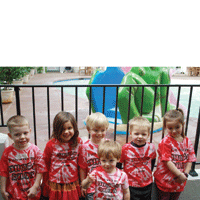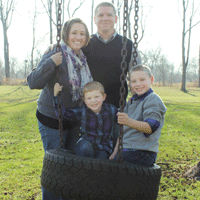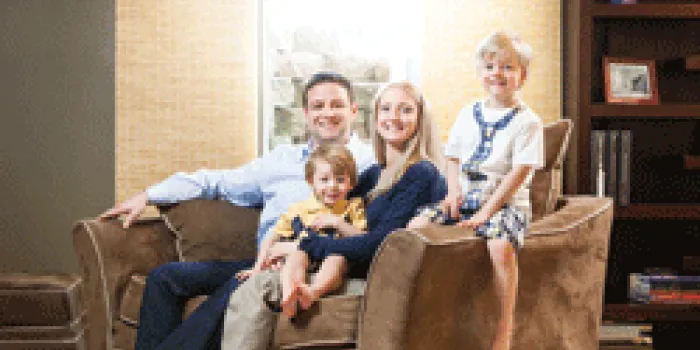In July 2011, a series of contradictory blood tests on their infant son, Ty, played with the emotions of Joni and Neil Rezac. The first test came back normal, the second confirmed a diagnosis of mild hemophilia A, and the third elevated that to severe. “The time of his diagnosis was one of the worst events of our life,” says Joni, 29, a part-time ultrasound technician from Grainger, Iowa. With no family history of hemophilia and a healthy first child, Jack, then 1, the Rezacs were hungry for information and support. They found both at their local chapter, Hemophilia of Iowa (HOI) in Cedar Rapids.
“At the First Step event, there were parents of young children, so we were on the same page, on the same level,” Joni says. “They had recently gone through a lot of the same things we were.”
Parents of newly diagnosed children are drawn to other parents who are a little farther ahead on the journey of raising a child with a bleeding disorder. They connect in a variety of ways, including during educational programs and social events at their chapter, and at the National Hemophilia Foundation’s (NHF’s) Annual Meeting. Some bond through social media.
Chapter Programs Prioritize Parents
Two programs were created in 1995 to address the needs of parents of children recently diagnosed with a bleeding disorder. One was NHF’s First Step program, a partnership with the US Centers for Disease Control and Prevention. The other was Parents Empowering Parents (PEP), created in part by Danna Merritt, MSW, LMSW, of Children’s Hospital of Michigan in Detroit and sponsored by Bayer. Both programs use teams of chapter or association staff, nurses and social workers from the hemophilia treatment center (HTC), and experienced parents to provide education and support to families with a child newly diagnosed with a bleeding disorder.

NHF’s First Step program
was created in 1995 to
help parents of children
recently diagnosed
with bleeding disorders.
NHF’s First Step program now has an online educational tool housed on the Steps for Living Web site, but in-person programs are still effective. “First Step has been monumental for our chapter,” says Kari Atkinson, HOI president and First Step parent coordinator. Prior to introducing the program, HOI had few young families involved. “Now we are very strong in reaching out to families with younger children who have a bleeding disorder.” The First Step curriculum has been updated and expanded, including information for children ages 8 and up.
The help families receive from First Step is practical. “We get all kinds of tips, like the double diapering and how to make different compression devices for infant hands and feet,” Joni says. Advice can be general or personal. At one HOI First Step event, a family who had recently found out their genetic status was wrestling with having another child. “It was interesting for those moms to connect who knew their genetic history and had decided to have more children,” Atkinson says. “The mentoring role occurs in a very nonformal, nonstructured way.”
That’s the case at the Mary M. Gooley Hemophilia Center in Rochester, New York. The HTC had a formal mentoring program that disbanded, but now it encourages mentoring to occur spontaneously. “It’s an informal matchup, based upon the new family’s need, their location and even something intangible—chemistry,” says Eric Iglewski, LMSW, social worker at the HTC. “As much as I like to artificially build bridges, when they’re built naturally they’re much better.”

The Rezacs have gotten
advice from other families
on childproofing, padding
and using a helmet.
Whether it’s an educational session led by a physician or a holiday party for 200, parents engage in conversation, says Iglewski. “There’s usually a lot of cross-talk, or what I call the ‘group after the group,’ where people will connect.”
For new families who seem overwhelmed, Iglewski plays matchmaker. “A lot of times people don’t know they need help, especially when they’ve just found out they have a child with a lifelong medical condition.” It’s important to acknowledge the family’s feelings of loss and grief, he says, and then introduce them to a seasoned family. Meeting the family of a high school varsity basketball player with hemophilia, for instance, can expand the new family’s focus. “It’s inspiring to them,” Iglewski says. “They feel, ‘I’m not alone and I’ve got hope.’ ” Parents are then able to shift from tunnel vision to a wider view, seeing for the first time that their child can lead a normal life.
Reassuring parents that their children are normal and showing them why are two of the goals of PEP, says Merritt. The program starts with medical information from an HTC nurse. “Knowledge overall is a huge comforting aspect,” says Jennifer Foster-Fausett, BSN, RN, of Providence Sacred Heart Medical Center Children’s Hospital in Spokane, Washington. When a child experiences a first bleed, families can be overwhelmed, she says. “Knowing to call the HTC helps integrate the knowledge and education learned at PEP.”
Alex and Staci Lowe’s first PEP meeting was a weekend retreat for eight couples when their son Brady, who has severe hemophilia A and is now 8, was 9 months old. “I learned a lot of basic tips on things we could do in our house to make it safer,” says Alex. He especially valued what the parents of toddlers and teens shared. “Just spending time with them and hearing their stories helped us,” says the 36-year-old church administrator for The Woods Church of the Nazarene. The family lives in Warren, Michigan. When Austin was born three years later, the Lowes were better equipped to deal with his severe hemophilia A and inhibitor.
It didn’t take much coaxing for Alex to join the PEP team. He is on the PEP Steering Committee and has helped conduct several trainings. “Parents are a key part of the training because they have the practical experience of living with children with a bleeding disorder,” he says. “Every time I do it, I learn something new from the parents, even though I am teaching.”
PEP helps families learn to communicate more effectively. “We encourage parents and kids to have regular family meetings, where we model and role-play that,” Alex says. Control is another tool PEP helps parents sharpen. “Sometimes that translates into people feeling they can take that family vacation because they feel they have control over what’s going on.”
Connecting on a Large Scale at NHF’s Annual Meeting
NHF’s Annual Meeting, which averages about 2,500 attendees, is often the first place parents meet large numbers of families with children with a bleeding disorder. Afterward, some develop lifelong friendships. Tashara Young, 34, a single parent from Selma, North Carolina, received an educational grant from NHF to attend her first Annual Meeting in Orlando in November 2012. She brought her daughter Tamala, 13, and two sons with severe hemophilia A—Anthony, 10, and Amear, 6, who has an inhibitor. “Just to walk in and see so many moms and dads telling the same story you have is amazing in itself,” she wrote in an e-mail to NHF’s Meetings Department. Some connect at the New Families Reception, others at introductory educational sessions, such as Hemophilia 101. During one of the educational sessions, parents discussed a new product. “It was good to get their feedback on things like that,” Young says.

Alex and Staci Lowe have
learned many things about
caring for their sons by
attending PEP meetings
and conducting trainings.
Before the conference, Young was protective of her sons. She said “no” frequently and restricted what they did, where they went and who they told about their diagnosis. “Going to that meeting, I thought, ‘My kids are able to do anything they want to do,’ ” she says. From the input of older parents, she gained some wisdom about disclosure. “It made me realize you have to pick and choose who you tell.”
Social Media’s Role
Social media comes in handy for parents who can’t attend face-to-face meetings. Young keeps in touch with others daily through Hemophilia Mothers, an international Facebook group. “It’s nice to know that you’re not the only one, that you’re all going through the same thing,” she says. The Mary M. Gooley HTC has a Facebook page. “People will link up and connect that way, too,” Iglewski says. “I don’t care how you connect, as long as you feel you’re in it with somebody else.” NHF’s Twitter and Facebook pages also bring parents together to help one another.
The Benefits of Belonging
The Rezacs have gotten through the doubts and concerns of Ty’s diagnosis. They are now enjoying his newfound age of exploration. At 18 months, Ty is a fearless “daredevil,” says Joni. She and her husband are weighing the advice of other parents who advocate childproofing, padding and using a helmet. They are also considering the arguments of more laid-back parents, and will then devise their own approach. “We try to go in the middle somewhere,” Joni says with a laugh.
Although people gain knowledge and skills, the greatest benefit from parenting programs may be the empathy they provide. “These groups help you feel that you do have support and you’re not alone,” says Joni. “There’s somebody else you can talk to who understands you and the condition—the stresses and the sorrows—because they’ve been through it themselves.”

